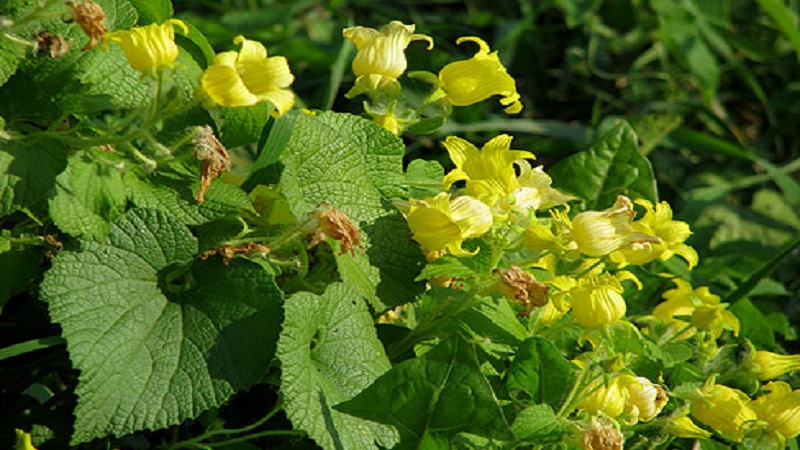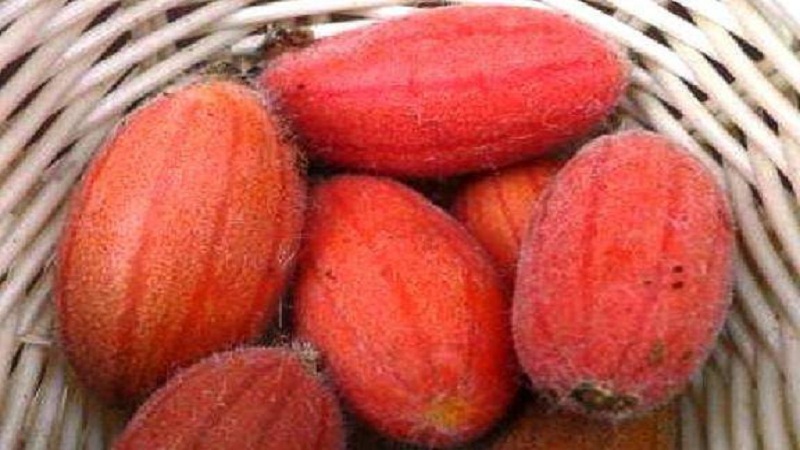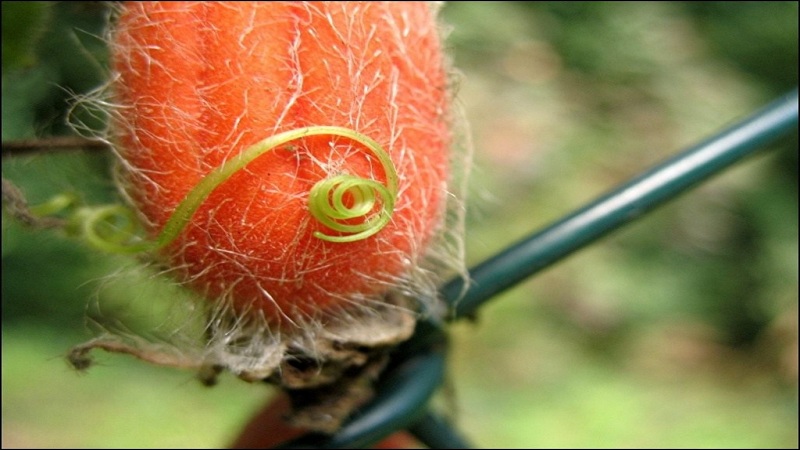What are red cucumbers (Tladianta Doubtful), what are they good for and what to do with them
Doubtful tladianta, or red cucumber is an exotic guest that has taken root in the climatic conditions of our country. There are 25 types of such cucumber, but we have only one frost-resistant species.
What kind of culture it is, how to grow it, where to use it, we will tell you in the article.
The content of the article
Red cucumbers, or Tladianta dubious
This plant is originally from the Far East, received a second name - red cucumber - due to the similarity of the fruits. It is part of the pumpkin family. At home, it is considered a rather aggressive weed that can grow even in the most adverse conditions.
In the photo - Doubtful Tladiant during the flowering period.

Feature and Description
Red cucumber is a herbaceous vine with a powerful root system... Young shoots are formed annually from tubers, since the ground part dies off with the onset of cold weather. Tubers are not afraid of sub-zero temperatures.
Numerous shoots, foliage, flowers and fruits are covered with tough, dense hairs. The tendrils are formed on the stems, with the help of which they cling to the supports and grow into a solid green carpet. The main stem reaches a height of 5 m.
Leaves are large (5-10 cm), light green, heart-shaped, with a pointed tip.
The dioecious plant forms male and female flowers, yellow or yellow-green hue. Male flowers are collected in inflorescences in the form of brushes, are bell-shaped and have a pronounced color. Female flowers are pale, expressionless, often solitary, flat in shape, appear later than male ones. Ovaries are formed at the base. Flowering period June - September.
Pollination in the homeland of the culture is carried out by wild bees of the genus Ctenoplektra. Others insects ignore the plant, therefore, in order to survive, it has adapted to vegetative propagation (by roots, cuttings). Under the conditions of our country, culture requires painstaking artificial pollination. This can be done with a soft brush or by applying anthers to the pistils. But there is another opinion, according to which, to obtain a harvest, it is enough for the flowers of the male and female type to start on the liana.
Important! Without pollination, the fruits of red cucumbers cannot be obtained.
Appearance and taste

The natural habitat of Tladiants is doubtful - coastal meadows, sandy deposits of the sea coasts, vegetable gardens and orchards.
The green fruits are heavily pubescent, the surface becomes smooth as it ripens. Ripe fruits are striped, orange or orange-red in color, 2-5 cm in size, they look like tiny cucumbers.
Fruiting period July - September. Green fruits have a herbaceous fresh taste. They can be used as usual cucumbers. The taste of ripe Tladianta is a mixture of exotic and pumpkin plants, reminiscent of a baked pumpkin with a kiwi and pineapple flavor. The pulp is soft, sweet, slightly cottony, inside contains many seeds in a dense dark shell.
Advantages and disadvantages
The dubious advantages of Tladians include:
- the possibility of using for medicinal purposes;
- great taste;
- unpretentious care;
- attractive appearance.
The main disadvantage is the rapid growth... For several weeks, the vine covers everything around, displacing other plants from the territory around the house.Gardeners spend years fighting an aggressive culture and sometimes cannot cope with lush greenery.
But there is a way out! To protect other plants, slate is dug into the ground around the perimeter of the red cucumber garden to a depth of 40-50 cm. This will stop the spread of roots throughout the site.
Agrotechnics
Red cucumber is grown in two ways: using seeds and tubers. The culture feels great in partial shade and in sun-drenched areas.
Preparation and landing
The plant is unpretentious to the climate and is capable of bearing fruit in any soil, even with a meager mineral composition.
Before sowing seedlings, the planting material is soaked in hot water for 5-6 hours, it is better to use a thermos for this. The containers are filled with a moist universal substrate and the seeds are spread to a depth of 2-3 cm. Seedlings appear at a temperature of + 15 ° C. The seedlings are "relocated" to a permanent place in early May. This method is used less often, but it is he who makes it possible to get a plant with male and female flowers.
The tuberous method of growing Tladiants is considered the simplest and is used more often. Planting is carried out in early spring to a depth of 6-8 cm with an interval of 70-80 cm. To prevent spreading throughout the site, a fence is preliminarily dug into the ground and tubers are planted in a confined space. The disadvantage of this method is that in appearance it is almost impossible to recognize which tubers will make a male and which will make a female plant.
Growing and care
Shoots from tubers appear in early May and grow at an incredible speed, clinging to the support with antennae. The male sprouts immediately lay inflorescences which bloom in June. Female flowers appear in July or early August.
Crop care does not require special skills and consists in pruning the lower shoots to prevent overgrowth. Priming watered 2-3 times a week and then loosened.
 To enhance budding, the soil is fertilized with a mixture of ash and superphosphate: 1 glass of ash is added to 3 liters of settled water, passed through a gauze filter. Then add 25 g of superphosphate and bring the solution to a volume of 10 l. For each square. m spend 5 liters of funds.
To enhance budding, the soil is fertilized with a mixture of ash and superphosphate: 1 glass of ash is added to 3 liters of settled water, passed through a gauze filter. Then add 25 g of superphosphate and bring the solution to a volume of 10 l. For each square. m spend 5 liters of funds.
To enhance fruiting, the soil is fed with a mullein: 4 buckets of water are taken for one bucket of fertilizer, mixed and left for 2-3 days. Then a bucket of solution is diluted with three buckets of water. 10 liters of fertilizer are enough for 1 m².
With the onset of frost, the ground part of the plant gradually dies off. The soil is dug up, some of the tubers are harvested. The rest will calmly overwinter in the ground.
Prevention of diseases and pests
The culture is susceptible to the same diseases as ordinary cucumbers:
- Fusarium wilting... Shoots at the base become brown in color, over time they become white or pink bloom and die off. For treatment use drugs "Fundazol", "Fitosporin-M".
- Anthracnose... Gloeosporium fungi cause the disease. On foliage and fruits, brownish-yellow spots of a round shape with cracks appear. Bordeaux mixture is used to fight.
- Powdery mildew. The leaves are covered with powdery spots, the plant gradually dies off if no action is taken. The drug Bayleton helps to cope with the problem.
- Bacteriosis... The disease is carried by insects. Holes form on the leaves, and brownish ulcers on the fruit. Processing is carried out using Bordeaux mixture or "Fitosporin-M".
The plant is loved by snails and slugs. Special traps, manual collection or granules of the "Thunderstorm" preparation help to deal with them.
Get rid of aphids drugs "Strela", "Fitoverm", "Tanrek" help. Of the folk remedies, irrigation with soapy water is considered the most effective. To do this, take 125 ml of liquid tar soap per 10 liters of water.
To combat whitefly use "Karbofos", "Bud".
Useful properties and application in traditional medicine
The fruits contain vitamins A, E, group B, magnesium, calcium and iron. Decoctions from tubers and seeds bring the greatest benefits to the body.
They are used for:
- prevention of influenza and ARVI;
- increasing the body's defenses;
- treating the digestive system;
- getting rid of headaches;
- elimination of sputum, bile and urine;
- treatment of the musculoskeletal system.

In our country, medicinal products are not widespread, and in eastern countries, seeds and tubers are used to prepare decoctions with a choleretic and diuretic effect. Infusions are able to liquefy and remove phlegm from the lungs and bronchi, have an astringent and antiscorbutic effect.
Red cucumber can help relieve high blood pressure and headaches. Flower tinctures are recommended for the treatment of influenza.
Gruel is made from the tubers and used as compresses to relieve the symptoms of osteochondrosis and sciatica.
Important! Self-medication is fraught with irreparable consequences. Before using funds based on Doubtful Tladians, consult a specialist.
Cooking use
Unripe fruits are used to prepare salads and unusual snacks. Ripe red cucumbers are suitable for making jam, jam, desserts and compote.
The taste of the fruit is quite specific, for an amateur, therefore, the culture is often used for decorative purposes. The fruits are combined with other fruits and vegetables during preservation.
Decorative function
Doubtful tladianu is used as a decor. Green foliage can ennoble rusty rainwater storage tanks, unremarkable wood and metal fences, garden pavilions and verandas, old tree trunks, and house walls. The plant looks unusual during abundant flowering, and a bunch of red fruits attracts the attention of passers-by.
Growing, liana creates a solid green hedge in just a few weeks. Tladiana can be planted in pots on the balcony.
Harm and contraindications
Red cucumber is banned for diabetics. Ripe fruits are high in sugar, which can lead to spikes in blood glucose levels.
For people with frequent allergic reactions to foods, it is advisable to refrain from eating fruits.
Where to buy seeds
You can buy seeds in gardening stores in your city or order in online stores.
Many gardeners sell red cucumber tubers. Perhaps your neighbor in the country has this amazing plant that he is ready to share.
Reviews
The opinion of summer residents about the advisability of growing a red cucumber was divided: some rejoice at the annual green hedge, others cannot cope with the wildly growing liana. As practice suggests, it all depends on the correct planting and care of the plant.
Valentina, Dzerzhinsk: «A friend, who has been growing it in the country for ten years, shared the tubers of a red cucumber. She taught me how to properly care for the plant. I planted the tubers near the house, my husband dug the slate into the ground to a depth of about a meter so that the rhizome would not spread throughout the territory. Now we have a green wall every year. We cultivate culture for the sake of decoration and don't bother with pollination. "
Vasily, Kursk: “Two years ago I bought the dubious Tladianta tubers on the announcement. In the first year I did not know how to deal with these weaving shoots, everything around was overgrown. In the fall, I dug up the entire site, removed all the tubers and planted it in a new way, made a fence. Now the plant lives in a strictly designated place. "
Vadim, Voronezh: “I became interested in growing red cucumbers in the country. I really liked how the plant wraps around fences and walls of houses. I dropped it off strictly according to the rules, dug in the slate. They say that special bees are needed for pollination, but in fact the plant must have female and male flowers.I bought three packs of seeds, grew seedlings, and as a result, in August I collected a small harvest of red fruits. Their taste is pleasant, sweet, but not for everybody. "
Conclusion
Despite the dubious ease of caring for Tladiant, not everyone will dare to plant a plant in their area if they find out what difficulties they will have to face. The main way to avoid overgrowth of vines is to limit the growth of rhizomes throughout the site. Sheets of slate, dug in along the perimeter of the house or fence to a depth of one meter, will help with this.
Exotic liana is mainly grown for the decoration of the territory. Growing up at an extraordinary speed, Tladianta is able to ennoble any place in the suburban area. Red fruits are used to make jam, jam, compotes, green pickle and salt.